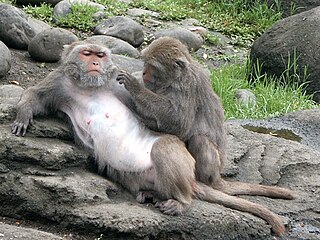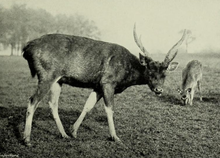
Taiwanese indigenous peoples, Formosan people, Austronesian Taiwanese, Yuanzhumin or Gaoshan people, are the indigenous peoples of Taiwan, who number about 569,000 or 2.38% of the island's population. This total is increased to more than 800,000 people if the indigenous peoples of the plains in Taiwan are included, pending future official recognition. Recent research suggests their ancestors may have been living on Taiwan for approximately 6,500 years. A wide body of evidence suggests Taiwan's indigenous people maintained regular trade networks with regional cultures before major Han (Chinese) immigration from continental Asia began in the 17th century.

The Austronesian languages are a language family widely spoken throughout Maritime Southeast Asia, Madagascar, the islands of the Pacific Ocean and Taiwan. There are also a number of speakers in continental Asia. They are spoken by about 386 million people. This makes it the fifth-largest language family by number of speakers. Major Austronesian languages include Malay, Javanese, and Tagalog (Filipino). According to some estimates, the family contains 1,257 languages, which is the second most of any language family.

The Formosan languages are a geographic grouping comprising the languages of the indigenous peoples of Taiwan, all of which are Austronesian. They do not form a single subfamily of Austronesian but rather nine separate subfamilies. The Taiwanese indigenous peoples recognized by the government are about 2.3% of the island's population. However, only 35% speak their ancestral language, due to centuries of language shift. Of the approximately 26 languages of the Taiwanese indigenous peoples, at least ten are extinct, another four are moribund, and all others are to some degree endangered.

The sika deer, also known as the spotted deer or the Japanese deer, is a species of deer native to much of East Asia and introduced to other parts of the world. Previously found from northern Vietnam in the south to the Russian Far East in the north, it is now uncommon except in Japan, where the species is overabundant.

Sambar is a lentil-based vegetable stew/soup, cooked with pigeon pea and tamarind broth. It is popular in South Indian and Sri Lankan cuisines.

The Formosan clouded leopard is an extinct clouded leopard population that was endemic to Taiwan. Camera trapping studies carried out in several protected areas in Taiwan between 1997 and 2012 did not record any clouded leopard. The population is listed as extinct on the IUCN Red List.

The sambar is a large deer native to the Indian subcontinent, South China, and Southeast Asia that is listed as a vulnerable species on the IUCN Red List since 2008. Populations have declined substantially due to severe hunting, local insurgency, and industrial exploitation of habitat.

Tamil cuisine is a culinary style originating in the southern Indian state Tamil Nadu and other parts of South Asia like Sri Lanka. Both Vegetarian cuisine and Non-Vegetarian cuisine is popular among the Tamil people and has been since ancient times. However, meats along with rice, legumes and lentils are also popular. Dairy products and tamarind are used to provide sour flavors. On special occasions, traditional Tamil dishes are served in a traditional manner, using banana leaves in place of utensils. After eating, the banana leaves are then used as a secondary food for cattle. A typical breakfast meal consists of idli or dosa with chutney. Lunch includes Rice, sambar, Curd, kuzhambu, and rasam.

The Formosan Association for Public Affairs (FAPA) is a Washington, D.C.-based nonprofit organization that seeks to build worldwide support for Taiwan independence. Its name "Formosan" refers to Taiwan's historical name of "Formosa", and its 43 chapters seek to advance the interests of Taiwanese people and communities around the world.

The Javan rusa or Sunda sambar is a deer native to Indonesia and East Timor. Introduced populations exist in a wide variety of locations in the Southern Hemisphere.

The Formosan rock macaque, also known as the Formosan rock monkey or Taiwanese macaque, is a macaque endemic to the island of Taiwan, which has also been introduced to Japan. Besides humans, Formosan rock macaques are the only native primates living in Taiwan. The species was first described by Robert Swinhoe in 1862.

Uthappam is a type of dosa from South India. In Tamil Nadu it is known as Uthappam (ஊத்தப்பம்), in Karnataka it is known as Uttappa (ಉತ್ತಪ್ಪ). In Kerala it is known as Oothappam (ഊത്തപ്പം) In Tulu it is known as Ootappa (ಊತಪ್ಪ) or Ootappo ( ಊತಪ್ಪೊ). Unlike a typical dosa, which is crisp and crepe-like, uttapam is thicker, with toppings. The name is derived from the Tamil words Appam and Utthia or Uttria, meaning Poured-Appam. Because Appam is cooked on a round bottom pan, whereas Utthia-Appam is cooked on a flat skillet. The Tamil ancient literature have a mention of it by its name. The classic breakfast of the Tamil residents consists of idli, dosai or uttappam mostly accompanied by sambar and chutney.

The languages of Taiwan consist of several varieties of languages under the families of Austronesian languages and Sino-Tibetan languages. The Formosan languages, a branch of Austronesian languages, have been spoken by the Taiwanese aborigines in Taiwan for thousands of years. Owing to the wide internal variety of the Formosan languages, research on historical linguistics recognizes Taiwan as the Urheimat (homeland) of the whole Austronesian languages family. In the last 400 years, several waves of Han emigrations brought several different Sino-Tibetan languages into Taiwan. These languages include Taiwanese Hokkien, Hakka, and Mandarin, which have become the major languages spoken in Taiwan nowadays.

The Taiwan Dog is a breed of small or medium dog indigenous to Taiwan. These dogs are also known as the Formosan Mountain Dog. They are well-adapted to the uneven and thickly forested terrain of Taiwan, having become a semi-wild breed prior to the arrival of several colonial reigns and foreign powers. Notwithstanding these adaptations, Formosans retained the potential to be trained and are now used as hunting dogs, guard dogs, stunt dogs, rescue dogs, or simply as companions. Formosans are classified into one medium type and two small types.

The East Formosan languages consist of various Formosan languages scattered across Taiwan, including Kavalan, Amis, and the extinct Siraya language. This grouping is supported by both Robert Blust and Paul Jen-kuei Li. Li considers the Siraya-speaking area in the southwestern plains of Taiwan to be the most likely homeland of the East Formosan speakers, where they then spread to the eastern coast of Taiwan and gradually migrated to the area of modern-day Taipei.

The Northern Formosan languages is a proposed grouping of Formosan languages that includes the Atayalic languages, the Western Plains languages, and the Northwest Formosan languages.

The Deer Park, Hisar, on Hisar-Dhansu in Hisar city of Haryana state in India has an area of 19 hectares including a 6-acre plot for producing fodder for the deer. Park as 4 species, blackbuck, chital spotted deer and 6 sambar. It also doubles up as the wildlife rescue clinic for the treatment injured wild animals and birds brought here by the people, which are released back in to the wild after the recovery.

The New Southbound Policy is an initiative of the Government of the Republic of China (Taiwan) under President Tsai Ing-wen that aims to enhance cooperation and exchange between Taiwan and 18 countries in Southeast Asia, South Asia and Australasia.

















